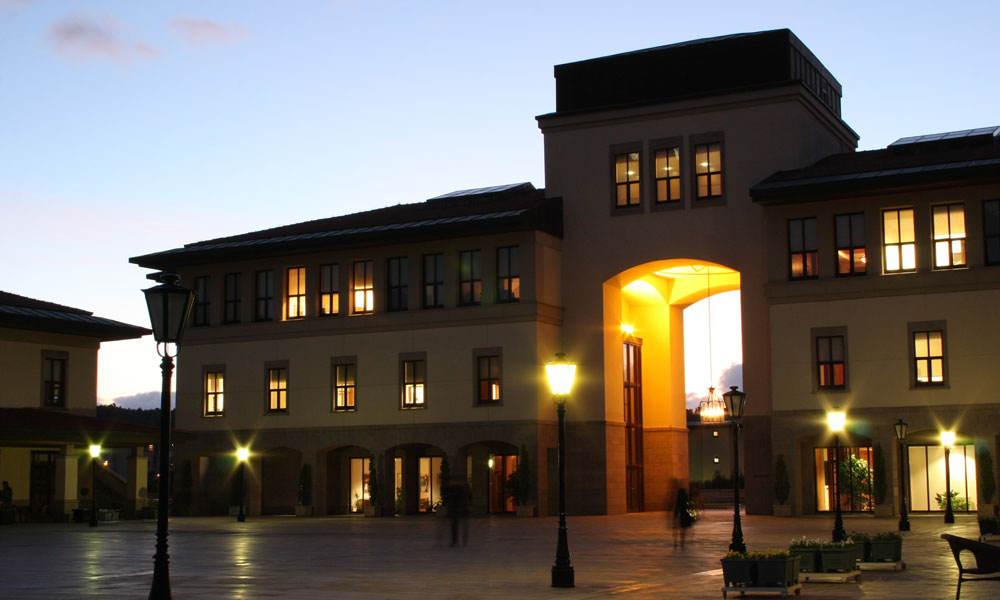
In commissioning the new campus, Koç family sought a design which would become an iconic Bosphorus landmark and a treasured part of Istanbul’s architectural heritage.
Koç University is grateful to Mozhan Khadem, the prominent Boston based American-Iranian architect of its beautiful campus, who grasped the design intent of the project with passion. Khadem’s design aim to integrate the campus with the steep contours of its natural hilly and forest environment. Beyond this, the campus design reflects Khadem’s respect for Turkish artistic and poetic heritage, his deep appreciation of the works of Mevlana “Rumi”, and his familiarity with different Turkish and Ottoman architectural styles.
The campus design incorporates functionality and state of the art of technology, with an architectural style that emphasizes a unique “sense of place”. Khadem’s design philosophy is that architecture should be the outward expression of the culture of its users, should be in organic harmony with its natural setting, and should foster appreciation of its local and national, cultural identity. In this way, architects have a unique ability and responsibility to promote multi-cultural understanding, to enhance appreciation of human diversity, and to help promote world peace.
The campus design emphasizes the theme of “Light” and the geographic importance and uniqueness of the Bosphorus. During an initial visit to the site, cognizant that he was standing in Europe yet gazing across the Asian shores, Khadem recalled the poet Rumi’s description of a bird flying from East to West, as swiftly as the“Sun of the Orient charges onto Turkish land”. Khadem felt that in this poem, Rumi was expressing his theosophical concept of the “Orient of Light”. In that very moment, Khadem felt that the guiding principle for the campus design should be the concept of an East-West axis within which would stand an iconic.
“Portal”of knowledge and light: This “Portal”, Khadem felt, should simultaneously symbolize the role of Koç University as a gateway of knowledge, and the historic role of Türkiye as the gateway between East and West. It should also stand as a tribute to the mystical wisdom of great sages, like Rumi.
Khadem believes that because learning is a continuous, organic process, the campus architecture should not be compartmentalized into isolated or disconnected buildings. His design concept therefore emphasizes a continuity of connected buildings surrounding a variety of interlocking courtyards of different sizes and functions. It is within both the common hallways of these interconnected buildings and these courtyards that social life of the campus thrives, wherein multidisciplinary interaction flourishes, and great ideas emerge. Reminiscent of the Ottoman architectural tradition, these campus courtyards unfold into each other in a surprising fashion, for it is not until reaching the end of a particular courtyard that the next courtyard suddenly becomes visible, thereby opening new and unexpected vistas to the observer.
The campus is compact and is designed for pedestrians. One can travel its entire length in twelve minutes on foot. The student and staff can move from place to place either in the open courtyards or under cover, during inclement weather. The campus is designed on the basis of a flexible planning module of four by four meters, combinations of which can accommodate different spatial needs of the campus, ranging from offices to classrooms and laboratories.
Symbolism:
The campus architecture is replete with symbols pertaining to Turkish history and culture. For example, the gilded ceiling design of the “Portal of Knowledge” symbolizes the mystical concept of the “heaven of understanding,” the Portal’s inlaid stone floor represents the seasons as well as the signs of the zodiac, and the geometry of the “Koç Square”, particularly its obtuse angular opening, is a symbolic tribute to the glory of the rising sun. Similarly, the “Memory Walk” and “Memory Wall”, replete with sculptures, machinery, and photographs, illustrate Türkiye’s historical development from ancient past to the modern day. The mosaic inlays around the campus pools, fountains and trees were inspired by Turkish artistic designs. The abstract modern design of the University’s “Metal Gates” recalls the interlocking Kufic calligraphy of the Ottoman period. These and other symbols have been employed in order to evoke the “sense of place” which is at the heart of Khadem’s design philosophy.
Special Spaces:
Currently the Koç University campus contains over 230,000 square meters of built area. This area is replete with special spaces that are intended to promote meaningful and inspired student interactions. Aside from the “Portal of Knowledge”, these include the built-in and sunken seating arrangements under the shade of trees, the modern Ottoman-style open pavilions, the distinctive private seating and walking spaces along the “Bosphorus Terrace”, the waterside residence-style “Bay Windows” and recessed seating along the courtyard facades, the sunken and raised seating alongside the pools and fountains, the colonnaded entrance to the “University Auditorium”, the welcoming façade of the campus “Entry Crescent”, and the open field of the “Campus Common”. Another distinctive space is the central hub of the campus: the “Grand Stair” which runs through the bustling “Student Center” and connects the “Koç Meydan” to all the visible lower levels of the building and then further downwards to the main cafeteria, numerous restaurants, and the “Campus Common”. Likewise, numerous group-seating spaces are interspersed throughout the “Koç Meydan” and the formal university “Entry Court”. This “Entry Court” also features a grand circular pool and fountain.
All of these distinctive spaces are intended to enhance the quality of student life, to provide an inspiring environment for study, individual reflection, and group interaction, and to provide students with intimate memories that they will cherish with nostalgia after their graduation from Koç University, and indeed throughout their entire lives.
Prepared by Koc University based on the information received from Mozhan Khadem
November 27, 2017







